|
|
Post by cobber on Oct 17, 2009 13:45:32 GMT 10
Williamson Page and Murphy made the “W.P.M.Caravan” This advertisment was in the “Australian Home Beautiful” June 1st 1933. 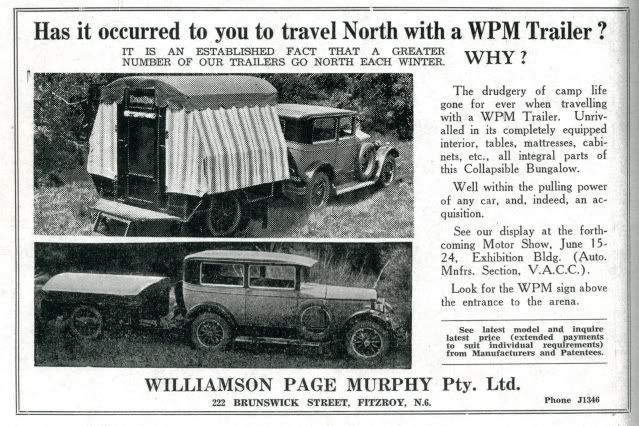 These advertisements for Williamson Page and Murphy date from 1934 through to 1937.... 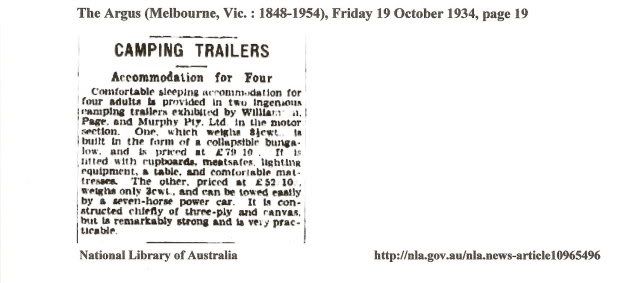 This one from “The Argus” Tuesday 18th 1935. 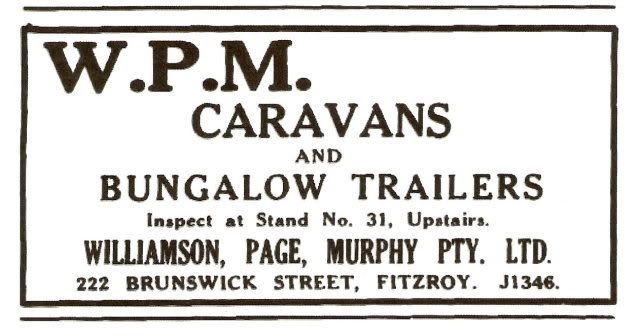 And from “The Argus” Tuesday 23rd February 1937 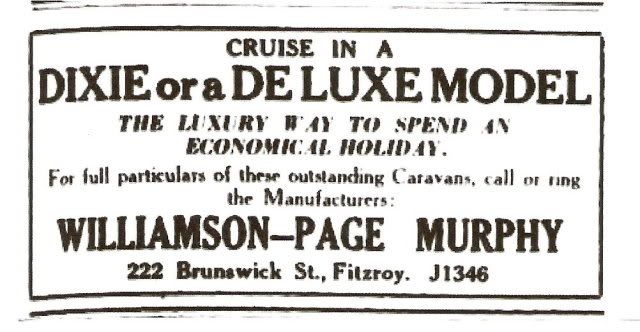 Cobber. |
|
|
|
Post by Don Ricardo on Aug 12, 2022 12:51:40 GMT 10
Morning all, We are familiar with the WPM 'bungalow trailers' or camping trailers produced in the 1930's from the information posted above by Cobber back in 2009. One of the adverts Cobber posted states "Cruise in a Dixie or a De Luxe model", and I think that we assumed that may have been the names of the bungalow trailer models. However, the advert below, published in The Australian Home Beautiful magazine (Vol 14, No 9 page 53) on 1 September 1936, tells us that in fact the Dixie and the De Luxe model were full size caravans: 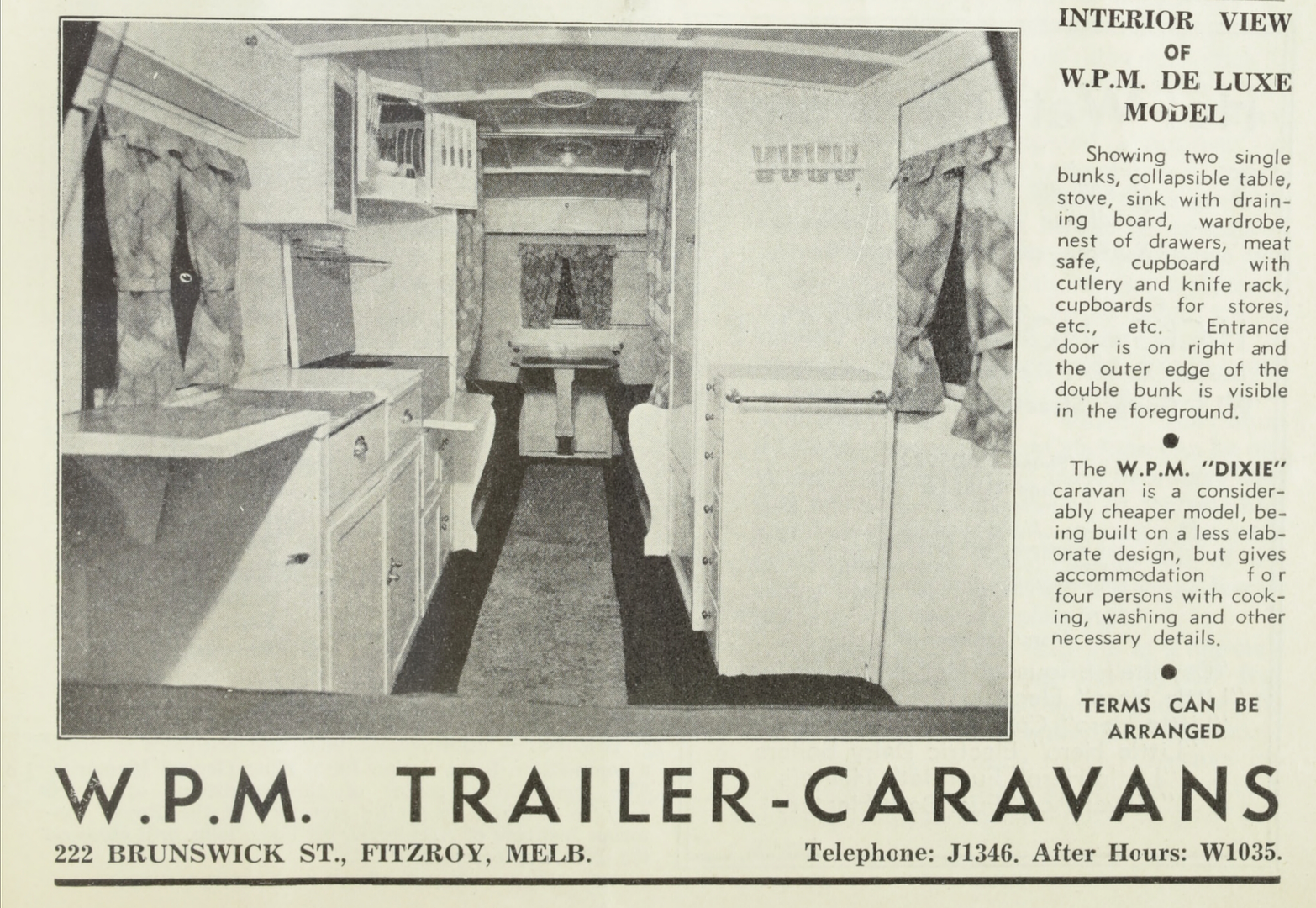 (Source: National Library of Australia - click here)
The De Luxe model had a number of upmarket features for the time: note the cupboard with the plate rack above the stove alcove, the fold down rack in the stove alcove itself, and the glass rack to the left of the door. It also appears that the De Luxe didn't have a standard roof hatch, but a vent in the ceiling instead.
So...another surprise brought to us from the Trove archive!
Don Ricardo
|
|
|
|
Post by Don Ricardo on Aug 14, 2022 13:35:19 GMT 10
Hi all, Following the post about WPM caravans, Andrew Woodmansey ( Woody99) had sent me two interesting items regarding the earlier WPM 'bungalow trailer' (camping trailer). The first item announces 'the new WPM collapsible bungalow trailer' and was published in the Melbourne Herald on Thursday, 18 December 1930 (page 24): _Thurs_18Dec1930_p24_article242764384.png?width=1920&height=1080&fit=bounds) (Source: National Library of Australia nla.gov.au/nla.news-article242764384Note that the layout of the article has been altered to improve readability on the forum.) The section commencing 'Luggage Racks' is a bit hard to read, so here is a transcription of those paragraphs: "LUGGAGE RACKS
Full length luggage racks solve the problem of the disposal of suitcases, clothing, etc., while two more spacious compartments at the rear, underneath the seats, give extra space.
At the front of the trailer is a full-size fly-wire door, with canvas blind, which can be rolled down, to give weather protection and privacy.
The construction of the trailer itself is a wooden frame covered with three-ply and strong striped canvas, and with leather hood material over the roof. Having four specially hinged legs, it stands rigidly, connected to, or disconnected from car.
While being high and dry, it Is only 1ft. 3in. off the ground, thus entailing no strenuous climbing in and out.
Messrs Williamson Page Murphy Ltd. of Brunswick Street, Fitzroy, have used their long experience as sidecar manufacturers in the construction of the very efficient independent trailer chassis. Long half-elliptic springs, supporting the body, are mounted on either side of the chassis, directly under the wheel axle, thus the weight of the trailer is taken directly at the wheels, allowing no possibility of bending the axle. The springs are provided with shock absorbers. A patented universal coupling connects trailer to car, and by its method of connection, enables car and trailer each to move independently and naturally on the surface of the road, without stress or strain on either trailer or car."
This article is of interest not only because it tells us a bit about the construction and features of the 'bungalow trailer', but also the date of the article (December 1930) tells us that WPM was producing their collapsible 'trailer caravan' at least as early as 1930. Note too the comment "Women who hitherto have refused to go camping because of the difficulties and discomforts met with in ordinary camp life, will become ardent enthusiasts on viewing the facilities offered in this unique trailer". Articles on caravanning in the 30's often commented on how women would be won over to camping by the 'luxuries' afforded by the vehicle concerned! The article mentions Williamson Page and Murphy's experience in building motorbike sidecars, and Andrew has provided an item showing one of their sidecars that was on display at the 'All Australia Exhibition' held in Adelaide in March 1930. The photo was published in the Adelaide Register News Pictorial on Wednesday, 26 March 1930 (page 19):
The first article above also refers to WPM's 'patented universal coupling' fitted to the Bungalow trailers. However, another item provided by Andrew tells us that apparently the coupling could be problematic, as reported in this article printed in the Melbourne Age newspaper on Friday, 26 May 1933 (page 15):
The unnamed defendant, who was being sued for the unpaid sum of £10 by Willamson Page and Murphy, had purchased a WPM bungalow trailer that he was told had been on show at the Melbourne and Sydney shows. Subsequent to purchase the coupling broke and repairs were carried out by WPM at no cost, and the defendant was told he would have no more trouble. However, on a trip to Sydney, the coupling broke again, causing damage to the axle, the loss of a wheel and other damage. The defendant was refusing to pay for the repairs to the trailer on the grounds of an implied guarantee after the first repair. WPM as the plaintiff claimed that no guarantee or warranty had accompanied the repairs.
All this just goes to show how far we've come in consumer law since the 1930's. First the product now would come with a guarantee for any breakages or faults within a certain period, and second any warranty repairs would come with a guarantee unless the repairer specifically indicated that no guarantee could be provided. Hopefully WPM didn't have too many of these incidents!
Thanks to Andrew Woodmansey for providing these items that expand our knowledge about WPM.
Don Ricardo
|
|